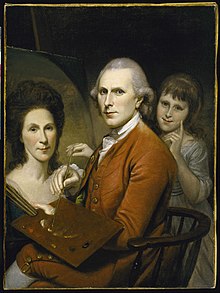Charles Willson Peale
In 1775, inspired by the American Revolution, Peale moved from his native Maryland to Philadelphia, where he set up a painting studio and joined the Sons of Liberty.He completed portraits of scores of historic figures, including Benjamin Franklin, John Hancock, Thomas Jefferson, Alexander Hamilton, James Mitchell Varnum, and George Washington.Jefferson referenced the existence of these "mammoths" (which he believed still roamed northern regions of the continent) as evidence for a greater biodiversity in North America.Peale's display of these bones drew attention from Europe, as did his method of re-assembling large skeletal specimens in three dimensions.This system drew a stark contrast between Peale's museum and his competitors who presented their artifacts as mysterious oddities of the natural world.Peale died on February 22, 1827, and was buried at St. Peter's Episcopal Church in Philadelphia alongside his wife Elizabeth DePeyster.[15] A Renaissance man, Peale had expertise not only in painting but also in many diverse fields, including carpentry, dentistry, optometry, shoemaking, and taxidermy.In 1802, John Isaac Hawkins patented the second official physiognotrace, a mechanical drawing device, and partnered with Peale to market it to prospective buyers.[16] Around 1804, Peale obtained the American patent rights to the polygraph from its inventor John Isaac Hawkins, about the same time as the purchase of one by Thomas Jefferson.Peale and Jefferson collaborated on refinements to this device, which enabled a copy of a handwritten letter to be produced simultaneously with the original.








National Portrait GalleryWashington, D.C.ChesterProvince of MarylandBritish AmericaPhiladelphiaPennsylvaniaSaint Peter's Episcopal ChurchyardPaintingAmerican RevolutionMarylandSons of LibertyAmerican Revolutionary WarPennsylvania MilitiaContinental ArmyPhiladelphia MuseumWashington at PrincetonYale University Art GalleryThe Artist in His MuseumPennsylvania Academy of the Fine Artstrompe-l'œilRaphaellesmallpoxThomas JeffersonRevolutionary WarSt. Peter's Episcopal ChurchChester, MarylandJames PealeNathaniel RamseyCongress of the ConfederationThirteen ColoniesJohn HesseliusJohn Singleton CopleyJohn Beale BordleyBenjamin WestAnnapolis, MarylandLa Salle UniversityGeorge WashingtonBattle of TrentonBattle of PrincetonBenjamin FranklinJohn HancockAlexander HamiltonJames Mitchell Varnumseal of MarylandPhiladelphia Museum of ArtPeale's Philadelphia Museumnatural historyAmerican Philosophical SocietymastodonmammothGeorges CuvierNew YorkComte de BuffonLinnaean taxonomyIndependence HallP. T. BarnumMoses KimballAngelica KauffmanRaphaelle PealeRembrandt Pealemuseum owner/operatorBaltimoreBaltimore Gas and Electric CompanyRosalba Carriera PealeRubens PealeSophonisba Angusciola PealeColeman Sellers IITitian Ramsay Peale IJohannes de PeysterCharles LinnaeusFranklin PealePhiladelphia MintTitian Ramsay Peale IIQuakerMoses WilliamssilhouetteGermantownBelfieldRenaissance mancarpentrydentistryoptometryshoemakingtaxidermyJohn Isaac HawkinsphysiognotracepolygraphWorld War IILiberty ShipAnne Catherine Hoof GreenCymbelineJohn Philip de HaasMartha WashingtonWilliam SmithJohn LaurensBaron Frederick William von SteubenArmand Tuffin de La RouërieArthur St. ClairWilliam MoultrieNathanael GreeneBenjamin LincolnHenry KnoxLafayetteTilghmanBrooklyn MuseumJohn HazelwoodTimothy MatlackCharles PettitDavid RittenhouseJoseph BrantJames WilkinsonMeriwether LewisWilliam ClarkYarrow MamoutPeale's Barber Farm Mastodon Exhumation SiteGeorge Escol SellersBarratt, Carrie ReboraWard, David C.Library of CongressPortrait of Yarrow MamoutPeale MuseumCharles Willson Peale HouseTitian PealeMary Jane PealeCharles Coleman Sellers